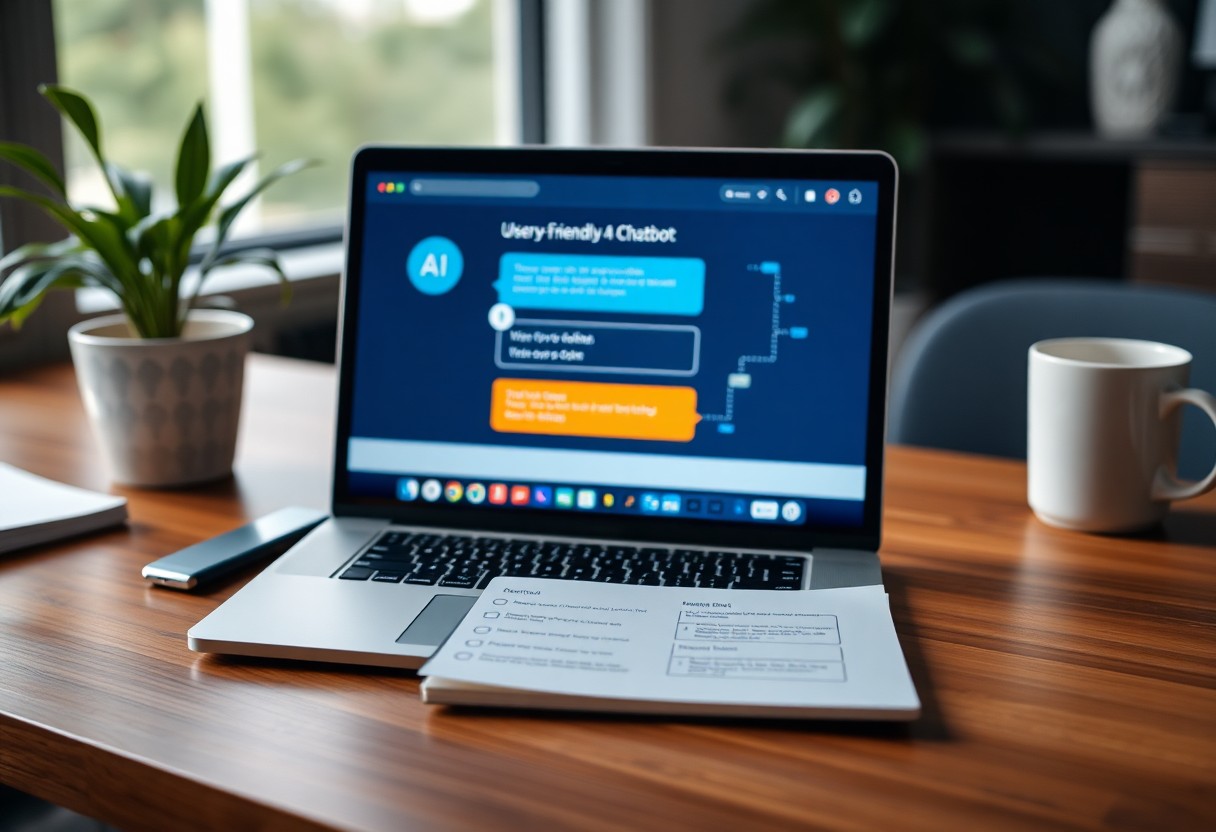NoCode solutions have revolutionized the way you can integrate technology into your business without needing extensive programming knowledge. In this guide, you will discover six straightforward steps to create an AI-powered chatbot that enhances customer engagement and streamlines operations. By leveraging user-friendly tools, you can develop a chatbot tailored to your business needs, improving efficiency and customer satisfaction. Let’s examine the necessary steps to get you started on your no-code chatbot journey.
Understanding No-Code Chatbots
What is a No-Code Chatbot?
A no-code chatbot enables you to create a conversational AI without any programming skills. Utilizing visual interfaces and templates, these platforms allow you to design, customize, and deploy chatbots quickly, focusing on functionality over coding complexity.
Benefits of Using No-Code Solutions
No-code solutions streamline the chatbot creation process, making it accessible to individuals and businesses regardless of technical expertise. Speed, ease of use, and cost-effectiveness are primary benefits that empower you to launch your chatbot without lengthy development cycles.
The elimination of coding barriers allows you to iterate and deploy updates rapidly. By utilizing pre-built templates, you can save time while still customizing chatbots to meet your specific needs. You gain greater control over the user experience, ensuring it aligns closely with your business goals. Many platforms also provide integrations with existing systems, enhancing functionality without requiring technical intervention. This flexibility and adaptability are key to responding swiftly to changing business requirements.
Key Features of an Effective Chatbot
An effective chatbot should encompass crucial features to ensure optimal user satisfaction and performance. Key features include:
- Natural Language Processing (NLP)
- Multi-channel support
- User analytics and reporting
- Seamless integration with CRM and other tools
- Customizable conversation flows
This set of features guarantees your chatbot can handle diverse interactions and contribute significantly to user engagement and satisfaction.
Incorporating advanced capabilities like NLP enables your chatbot to understand user intent accurately, providing relevant responses. Offering multi-channel support allows interactions across different platforms, increasing accessibility. User analytics and reporting generate insights into chatbot performance, guiding you toward continuous improvement. Integration capabilities streamline workflow and optimize service delivery, while customizable conversation flows ensure tailored user experiences. This comprehensive feature set establishes a powerful chatbot that meets diverse business needs effectively.
Identifying Business Needs
Assessing Customer Interaction Points
Identify where your customers frequently interact with your business, such as your website, social media pages, or customer support channels. Pinpointing these touchpoints enables you to understand the most effective areas where a chatbot can enhance user experience and improve response times, driving customer satisfaction and loyalty. For instance, if you receive numerous inquiries on product availability via social media, integrating a chatbot can streamline those interactions.
Defining Objectives for the Chatbot
Establish clear objectives for what you want the chatbot to achieve, whether it’s improving customer service, increasing lead generation, or enhancing user engagement. Setting specific, measurable goals will guide your chatbot’s design and functionality, ensuring it meets your business needs effectively. Consider goals like reducing response time by 50% or handling 75% of common inquiries autonomously.
Setting specific goals allows you to tailor the chatbot’s capabilities to fulfill your business’s unique requirements. For example, if your primary objective is to increase sales, focus on features that help with product recommendations or cart abandonment notifications. Alternatively, if customer support is your priority, creating a knowledge base for common queries might be beneficial. Aligning your bot’s functions with these objectives ensures that it delivers tangible results for your business.
Understanding Your Target Audience
Grasping who your customers are shapes your chatbot’s interactions significantly. Analyze demographics, preferences, and behaviors to craft a personalized experience that resonates with users. Utilizing analytics from previous customer interactions and feedback can guide the tone, style, and complexity of your chatbot’s responses, ensuring it caters to your audience’s specific needs.
Identifying your target audience involves looking beyond basic demographics to consider psychographics—understanding what drives your customers’ decisions. For instance, if your audience comprises tech-savvy millennials, you might design a chatbot that uses a more casual tone and offers instant solutions. Conversely, if your clientele is more conservative, a professional tone with detailed guidance may be more appropriate. Tailoring your chatbot to align with these preferences will create a more engaging and effective experience, fostering stronger connections with your brand.

Choosing the Right No-Code Platform
Popular No-Code Chatbot Platforms
A variety of no-code chatbot platforms exist, each offering unique features tailored to different business needs. Popular options include Chatfuel, ManyChat, and Tars, which provide intuitive interfaces and robust functionalities to create custom chatbots without coding skills. These platforms cater to various industries, enabling you to deploy engaging chat solutions quickly.
Comparing Features and Pricing
Evaluating features and pricing is important to ensure you select the best platform for your requirements. Key aspects to consider include integration capabilities, template availability, and analytics tools. Pricing often varies based on usage tiers, making it beneficial to analyze your expected chatbot traffic against the cost structure of each platform.
Features vs. Pricing Comparison
| Platform | Starting Price |
|---|---|
| Chatfuel | Free / $15/month |
| ManyChat | Free / $10/month |
| Tars | $49/month |
Analyzing features alongside pricing structures helps you make informed decisions. For instance, if you require advanced analytics, investing in a platform like Tars might be justified compared to basic offerings from free options. Consider your growth plans and long-term needs when evaluating potential costs against provided functionalities.
Evaluating User-Friendliness
User-friendliness directly impacts how effectively you can implement and manage your chatbot. Each platform should be easy to navigate, enabling you to design workflows and integrate your chatbot with existing systems effortlessly. Look for drag-and-drop functionality and accessible tutorials to minimize your onboarding time.
A user-friendly platform not only increases productivity but also enhances your ability to adapt the chatbot as your business evolves. Features like customizable templates and responsive support can significantly ease the learning curve. Free trials are beneficial to assess usability before making a commitment, ensuring you choose a platform that aligns with your comfort level and operational needs.
Designing Your Chatbot
Crafting the Conversational Flow
Establish a natural dialogue by structuring your chatbot’s conversational flow. Start with a clear greeting and guide users through a logical path of questions and responses. Utilize decision tree models to visualize and streamline the user experience, ensuring the chatbot can handle varied queries while maintaining a friendly tone.
Designing User-Friendly Interfaces
Aesthetic simplicity can significantly enhance user experience. Utilize clean layouts, intuitive navigation, and engaging visuals to ensure users can easily interact with your chatbot. Focus on minimizing options to avoid overwhelming users while providing quick access to crucial features like FAQs and customer support.
By prioritizing user-friendly interfaces, you facilitate a seamless interaction with your chatbot. Consider leveraging buttons, quick replies, and timestamps to enhance usability. A well-designed interface not only provides clarity but also encourages frequent use, as users will feel comfortable and less frustrated navigating through various options. Employ responsive design elements to ensure compatibility across devices for uninterrupted access.
Incorporating Brand Voice and Personality
Your chatbot should reflect your brand voice consistently throughout its interactions. Define a clear personality and tone that resonates with your audience, whether it’s friendly, professional, or humorous. This alignment fosters connection and reinforces brand identity in every customer engagement.
Incorporating brand voice into your chatbot involves using specific language and phrases that embody your company’s ethos. Tailor responses that not only convey information but also evoke your brand’s character. For instance, if your business embodies a playful spirit, don’t hesitate to use light-hearted jokes and casual language. Consistency in voice helps build trust and familiarity, encouraging users to engage more openly with your chatbot.
Integrating AI Capabilities
Understanding AI and Machine Learning Basics
AI and machine learning form the backbone of modern chatbots, enabling them to learn from interactions and improve over time. Familiarize yourself with key concepts like supervised and unsupervised learning, where supervised learning involves training a model on labeled data, while unsupervised learning lets algorithms identify patterns in unstructured data. Knowing these basics empowers you to choose the right tools for your chatbot.
Enhancing Conversational Ability with AI
AI enhances your chatbot’s conversational ability by enabling it to understand context, respond naturally, and adapt to user intents. By leveraging advanced algorithms, chatbots can decipher nuances in conversations and handle complex queries effectively, providing a more human-like interaction.
To achieve this, consider integrating pre-trained AI models or utilizing platforms that specialize in conversational AI. For instance, using frameworks like OpenAI’s GPT or Google’s Dialogflow allows your chatbot to engage in more dynamic conversations, making it capable of addressing a wide range of customer inquiries, from routine questions to more specific business-related issues. This adaptability not only improves user satisfaction but also increases engagement rates.
Implementing Natural Language Processing (NLP)
NLP is vital for allowing your chatbot to interpret and understand human language, transforming user inputs into actionable data. Incorporating NLP enables your chatbot to analyze conversation context, intent, and sentiment accurately.
Implementing NLP requires selecting appropriate libraries such as spaCy or NLTK, or utilizing cloud-based services like Google Cloud Natural Language API. Leveraging these tools, you can build features like intent recognition, which helps your chatbot categorize user inquiries, and sentiment analysis, allowing it to respond empathetically based on emotional cues. This integration can significantly elevate the effectiveness of your chatbot, making it not only a functional tool but also a vital part of your customer service strategy.
Testing and Iteration
Conducting Usability Tests
Usability tests allow you to observe how users interact with your chatbot. By creating scenarios for users to complete, you can identify pain points and areas of confusion. Tools like UserTesting or even simple screen-sharing sessions can help gather insights into the user experience, revealing any navigation issues or misunderstandings in responses.
Gathering Feedback from Users
Soliciting feedback from users is vital to understanding their experience. Post-interaction surveys or direct outreach can provide valuable insights into their satisfaction and any suggestions for improvement.
Utilize tools like Google Forms or Typeform to create short, targeted surveys that gauge user satisfaction and collect constructive criticism. Questions might include their ease of use, the accuracy of responses, or any unmet needs they experienced. Analyze this feedback systematically to identify patterns that highlight areas for enhancement.
Iterative Improvements and Updates
Implementing iterative improvements involves making adjustments based on user feedback and test results. Regular updates can ensure your chatbot evolves alongside customer expectations and needs.
Consider establishing a routine schedule for reviewing feedback and performance data. For instance, if users frequently mention difficulties with a specific function, you may prioritize refining that area. Utilize analytics to track engagement and satisfaction over time, making incremental adjustments that boost overall effectiveness and user experience.

Deployment and Monitoring
Launching Your Chatbot
Deploy your chatbot on multiple platforms where your customers engage, such as your website, social media, or messaging apps. Ensure your chatbot is easily accessible by placing it in a prominent location on your site. Set a specific launch date and prepare marketing materials to announce its availability, creating excitement among your audience.
Monitoring Performance Metrics
An effective chatbot relies on continuous assessment of its performance. Track important metrics such as user engagement rates, response times, and the number of interactions to gauge its efficiency. These metrics help you understand how well your chatbot meets customer expectations.
Utilizing analytics tools allows you to dive deeper into user behavior and preferences. Set benchmarks for success, such as aiming for a 90% satisfaction rate, and compare performance over time. Regularly analyze how users interact with the chatbot to identify improvement areas, such as frequently asked questions that aren’t being addressed effectively or features that lack engagement. Insights gained can guide updates and optimizations.
Ensuring Ongoing Maintenance and Support
Regular maintenance is imperative to keep your chatbot functioning effectively. Schedule routine checks to update content, troubleshoot issues, and integrate user feedback. Staying proactive helps maintain user interest and trust in your chatbot.
Develop a maintenance plan that includes regular updates based on evolving customer needs and technological advancements. As conversations and expectations shift, enhancing your chatbot ensures it remains a valuable resource. Consider establishing user feedback loops to gather insights on functionality and user satisfaction, which can guide continual improvement efforts.
Final Words
Ultimately, by following these 6 simple steps, you can effectively build a no-code AI chatbot tailored to your business needs. This process empowers you to enhance customer engagement, streamline operations, and provide instant support without needing extensive technical knowledge. Embrace the opportunity to integrate AI into your operations, and watch your business thrive as you connect with your audience in a more interactive and efficient manner.

